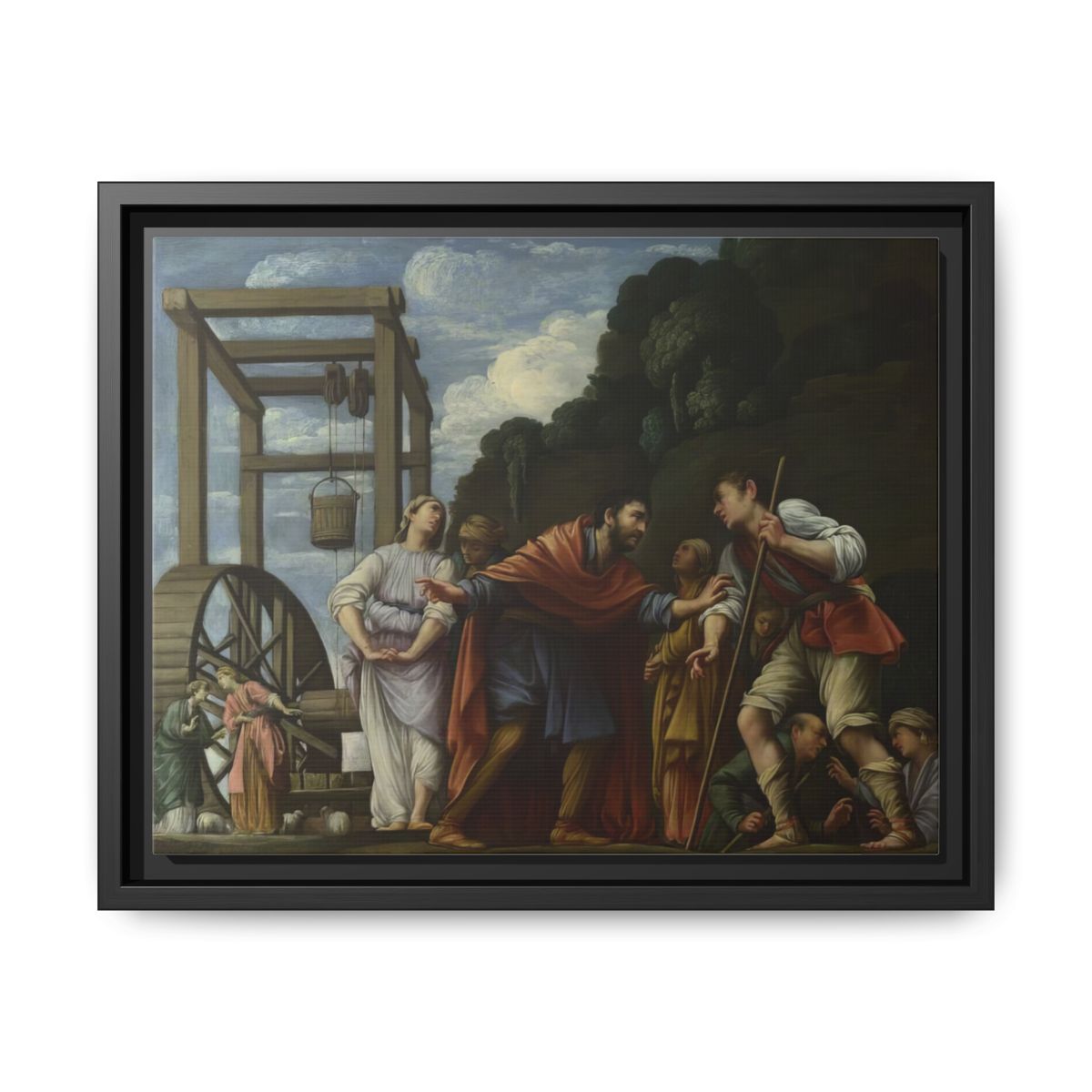Moses defending the Daughters of Jethro
Artist: Carlo Saraceni
Description: "Moses Defending the Daughters of Jethro" by Carlo Saraceni: A Baroque oil painting depicting Moses' heroic biblical act, rich in drama and religious symbolism.
Price: Select options to see price
Product Option:
Why You'll Love It
Moses Defending the Daughters of Jethro by Carlo Saraceni: An Analysis
The Artist: Carlo Saraceni
Carlo Saraceni (1579–1620) was a prominent Italian Baroque painter, renowned for his early adoption of Caravaggism and for bridging the influence of Caravaggio's revolutionary realism with the luminous colorism of the Venetian school. Born in Venice, Saraceni moved to Rome around the dawn of the 17th century, where he quickly absorbed the city’s vibrant artistic innovations. Though his career was brief, Saraceni’s works are celebrated for their precise draftsmanship, emotional immediacy, and masterful handling of light and color. As a key figure among the Caravaggisti, Saraceni played a formative role in shaping Baroque painting through his intense naturalism and vivid storytelling.
Historical Context of the Artwork
"Moses Defending the Daughters of Jethro," executed in oil on canvas, draws upon a narrative from the Book of Exodus (Exodus 2:16-21). In this biblical story, Moses, after fleeing Egypt, encounters the seven daughters of Jethro (the priest of Midian) at a well, where they are being harassed by shepherds. Moses intervenes, driving the shepherds away and aiding the women in watering their father's flock. Saraceni’s work was created during an era of significant religious and cultural transformation fueled by the Counter-Reformation, a period when the Catholic Church commissioned religious art to reaffirm its messages and instill virtue.
The Caravaggisti, including Saraceni, responded to this fervent religious climate by emphasizing directness, drama, and realistic portrayal of sacred narratives—so that ordinary believers could engage empathetically with the stories depicted.
Religious and Cultural Significance
The account of Moses and the daughters of Jethro is more than an episode of gallantry; it prefigures Moses’ future role as deliverer of Israel and emblem of divine justice. In Christian iconography, Moses often symbolizes moral courage, virtue, and the defense of the oppressed. The episode underscores themes of hospitality, providence, and divine appointment—themes that resonated strongly within the Counter-Reformation Church.
By depicting the future lawgiver as a protector of the defenseless, Saraceni’s painting aligns biblically inspired virtue with contemporary Christian ideals, making the scene not only a historical narrative but also a model of righteous conduct for viewers.
Symbolism and Iconography
Saraceni’s composition is notable for its clear narrative structure and rich symbolism. Moses is typically shown standing resolutely, identifiable through robust physicality and dynamic posture, embodying both physical and moral strength. The daughters of Jethro, often depicted in flowing garments, symbolize innocence and vulnerability. The threatening shepherds, aggressive yet faceless, represent lawlessness and chaos.
The well in the scene serves as a symbol of life, renewal, and providence—water being a recurring motif for divine care throughout the Old Testament. Moses’ act of defense thus becomes an act of spiritual purification: cleansing violence, ensuring justice, and sustaining life.
The staff Moses sometimes holds in such depictions already alludes to his future as shepherd of Israel and wielder of miraculous signs. Contrast between light and shadow within the painting often demarcates good from evil—Moses and the women bathed in radiant light, while the antagonistic shepherds lurk in darkness, enforcing a moral dimension through visual means.
Artistic Techniques Used
"Moses Defending the Daughters of Jethro" is exemplary of Saraceni’s unique synthesis of Venetian and Caravaggesque techniques. Unlike Caravaggio’s rugged Romans, Saraceni often infused his biblical figures with a lyrical grace reminiscent of Venetian masters like Titian and Veronese. Vibrant color, refined textures, and smoothly blended transitions characterize the figures and fabrics.
Caravaggio’s influence is most apparent in the naturalistic rendering and dramatic chiaroscuro. Saraceni uses strong contrasts of light and shadow to model the forms, heighten the emotional tension, and focus attention on the moment of confrontation. This layering of light not only dramatizes the narrative but also endows the characters with psychological depth.
Spatial arrangement is carefully calculated: the figures dominate the foreground, their gestures and gazes locked in tense interplay. Saraceni’s brushwork is assured and energetic, with attention to bodily movement and facial expression achieving an immediacy that draws viewers into the scene.
Cultural Impact
Carlo Saraceni's "Moses Defending the Daughters of Jethro" exemplifies the Baroque era’s fusion of vivid storytelling, moral didacticism, and painterly innovation. Works like this were powerful tools for teaching and devotion, making scriptural episodes accessible at both intellectual and visceral levels. By championing Moses—a paragon of justice and deliverance—Saraceni contributed to the broader Catholic effort of shaping religious identity through emotionally gripping and visually compelling imagery.
Moreover, Saraceni’s synthesis of Caravaggist and Venetian techniques would influence a generation of Roman painters, including his own pupils such as Jean Le Clerc, and ripple outward to the wider European Baroque. His renderings of biblical stories became models for devotional art, bridging realism and transcendence in ways that resonated far beyond his immediate context.
Sources
- Christiansen, Keith. "Carlo Saraceni." The Metropolitan Museum of Art.
- Spike, John T. Carlo Saraceni: Un veneziano tra Roma e l’Europa. Venice: Marsilio, 1992.
- Gash, John. Caravaggio. London: Chaucer Press, 2003.
- Hall, James. Dictionary of Subjects and Symbols in Art. London: John Murray, 1996.
- Exodus 2:16-21, The Holy Bible
Who Made It
Created by Carlo Saraceni.
All Available Options
Below is a list of all the available options for this product. If you don't see what you're looking for, please contact us.
Shipping & Returns
All items are custom-made just for you! We partner with JonDo for fulfillment, and your order will typically arrive within 2-5 days. Since each piece is crafted to order, we don't offer returns, but we've got your back—if there's a defect or an issue caused by us or shipping, we'll do our absolute best to make it right. Questions? Feel free to reach out!
